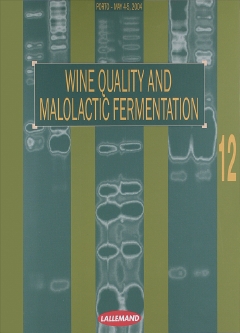Wine Quality and Malolactic Fermentation
| Auteur(s) auteurs | Colloque Lallemand N°12 - Porto - 2004 |
|---|---|
| Nb pages nb_pages | 63 |
| Année d'édition anneedition | 2004 |
| Langue(s) langues | N/A |
| Autres versions disponibles versions_disponibles | Aucune |
| Récompenses recompenses | Non |
| Franco France price | 35,00 € |
| Franco tous pays price_expo | 40,00 € |

FOREWORD
Wine producers must have increasingly technical oenological knowledge and must stay informed about the latest innovative practices. At the XVIe Entretiens Scientifiques Lallemand in Porto, the experts in malolactic bacteria presented the most recent advances in the field.
This meeting, which brought together key people from more than 15 countries on five continents, took a more practical turn this year, welcoming a dozen oenologists and winemakers to share their perspectives on the use of selected malolactic bacteria. Representatives of the wine trade also talked about how their own choices were dictated by the expectations of consumers.
Today, the principal concerns of winemakers gravitate around two main poles - how to maintain the typical characteristics of the wine offering consumers the utmost quality. Tim Atkin, Master of Wine and wine correspondent for The Observer in the UK, the moderator for the round table, summarized the discussions on the use of selected malolactic bacteria thus : "No one wants wine positive influence on the taste and aroma, malolactic fermentation represents only a part of the wine producer's work, which starts much sooner, in the vineyard itself".
Having obtained a number of different points of view during the debates and wine tastings, the technical team at Lallemand can direct the company's research towards offering oenological tools that are ever more adapted to the needs of the market.
CONTENTS
- Indigenous lactic acid bacteria and selected lactic acid bacteria
Aline Lonvaud-Funel - The buttery attribute of wine - Diacetyl. Desirability, spoilage and beyond. Butter or no butter
Evelyne J. Bartowsky and Paul A. Henschke - Aptitude of selected and wild strains of oenococcus oeni to induce MLF in harsh wines
Francesca Nannelli, Flavia Creatini and Iolanda Rosi - Yeasts-bacteria interaction - possible nutrient strategies
Thomas Henick-Kling, Kathleen Arnink, Lorenza Conterno, Carl Shively and Sibylle Krieger - Impact of S-containing amino acids and glutathione on growth of oenococcus oeni and malolactic fermentation
Doris Rauhut, Magdalena Gawron-Scibek, Beata Beisert, Marta Kondzior, Ralf Schwarz, Helmut Kürbel, Manfred Grossmann and Sibylle Krieger - Practical implications of the lactic acid bacteria genome project; malolactic fermentations
David A. Mills - Perception by wine drinkers of sensory defects caused by uncontrolled malolactic fermentation
Antonio Palacios, Carlos Suarez, Sibylle Krieger, Didier Théodore, Luis Otano and Francisco Pena - Malolactic fermentation without control…the masks
Didier Théodore, Antonio Palacios, Sibylle Krieger and Ann Dumont - Do malolactic bacteria influence wine quality?
Summary of the round table discussion
Tim Atkin, Moderator.
